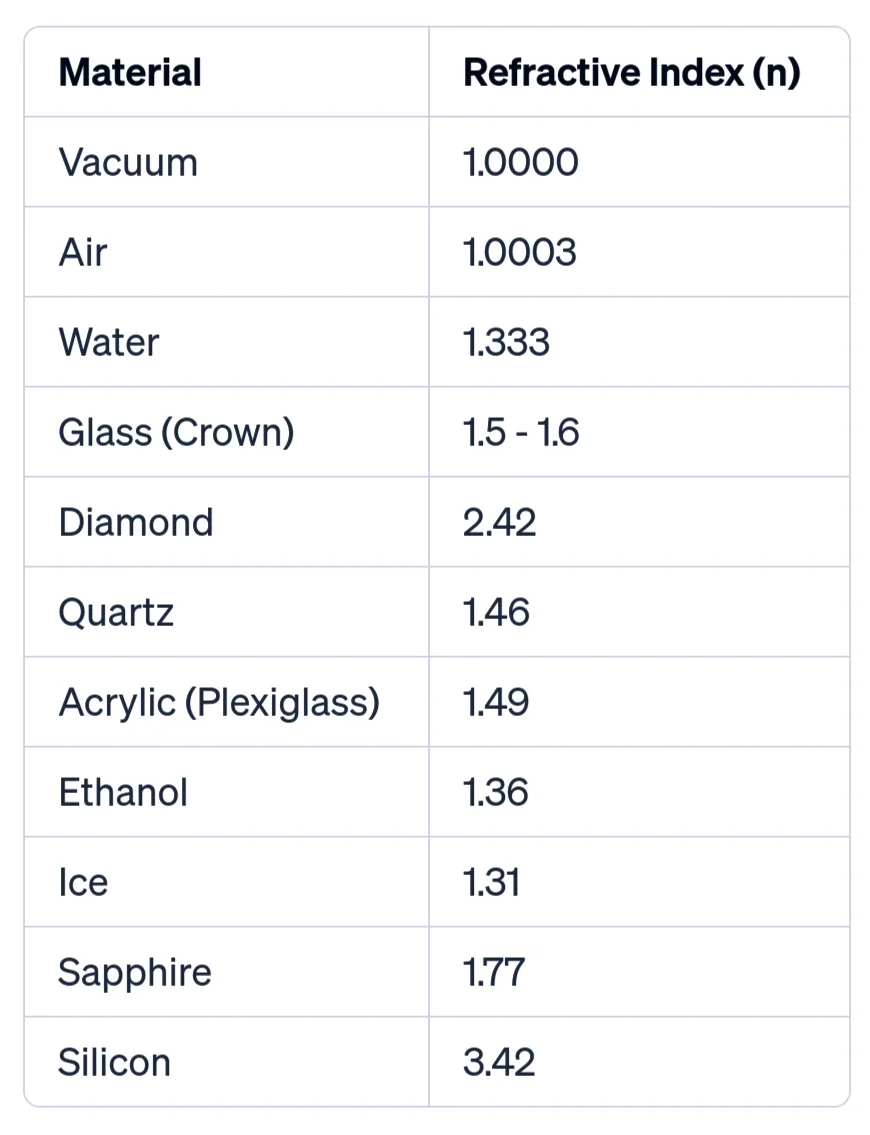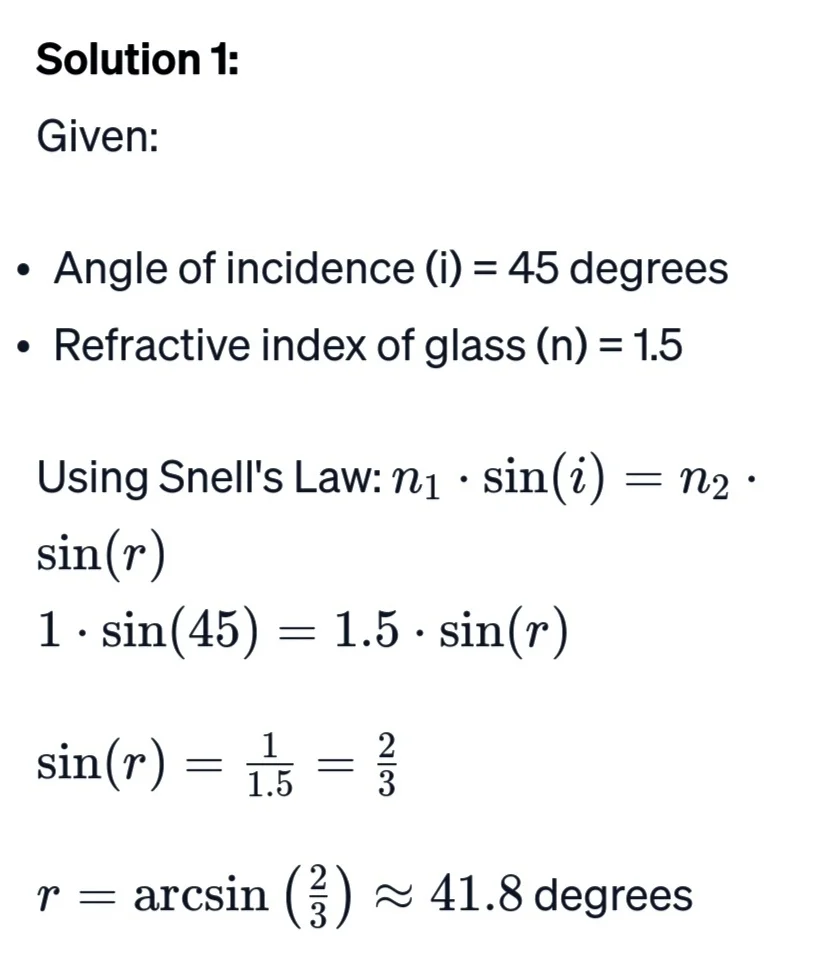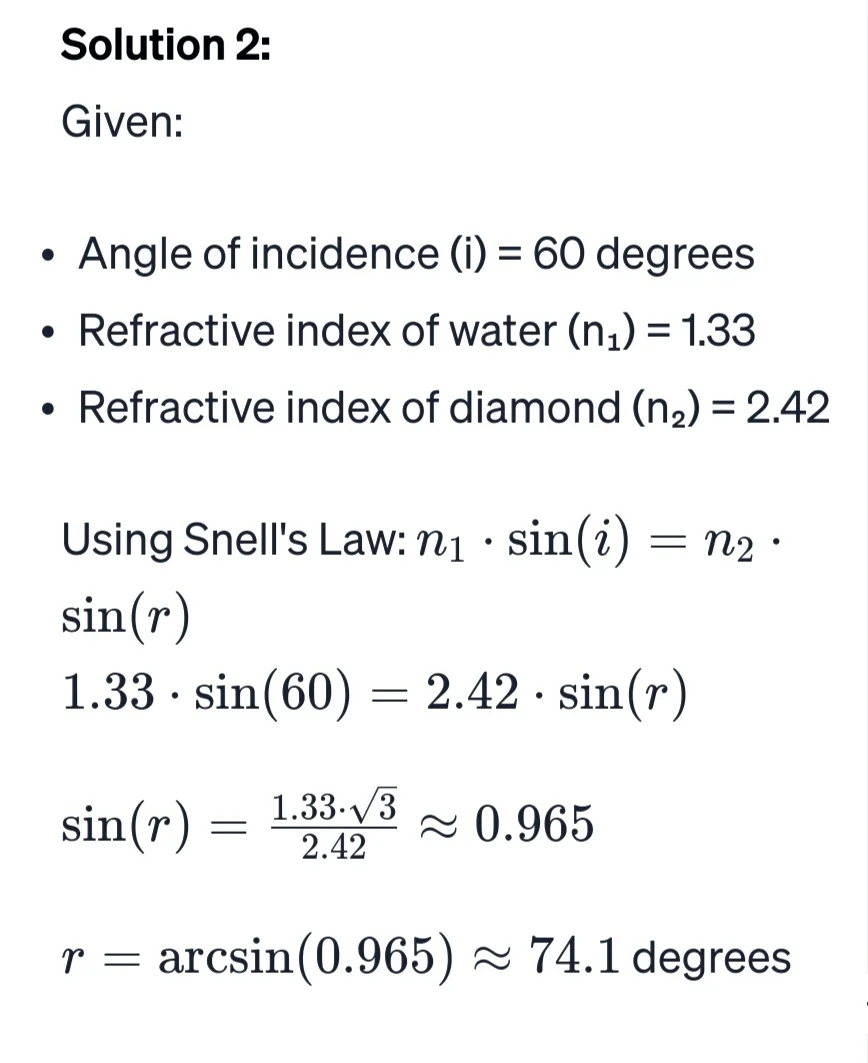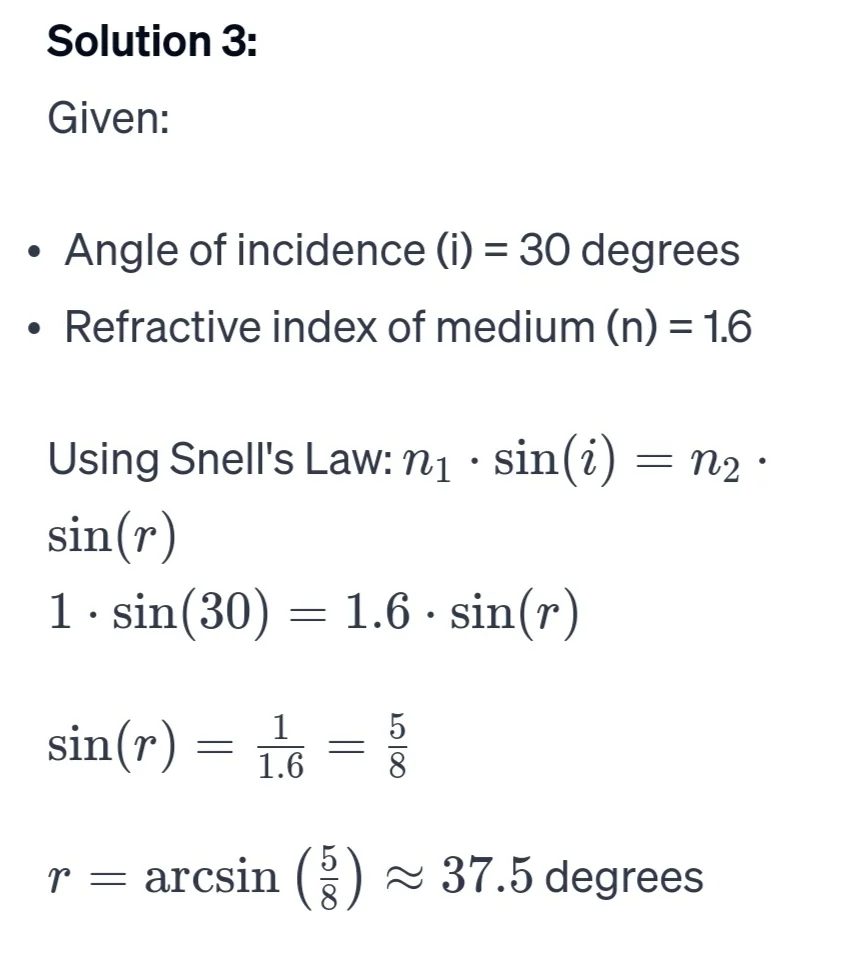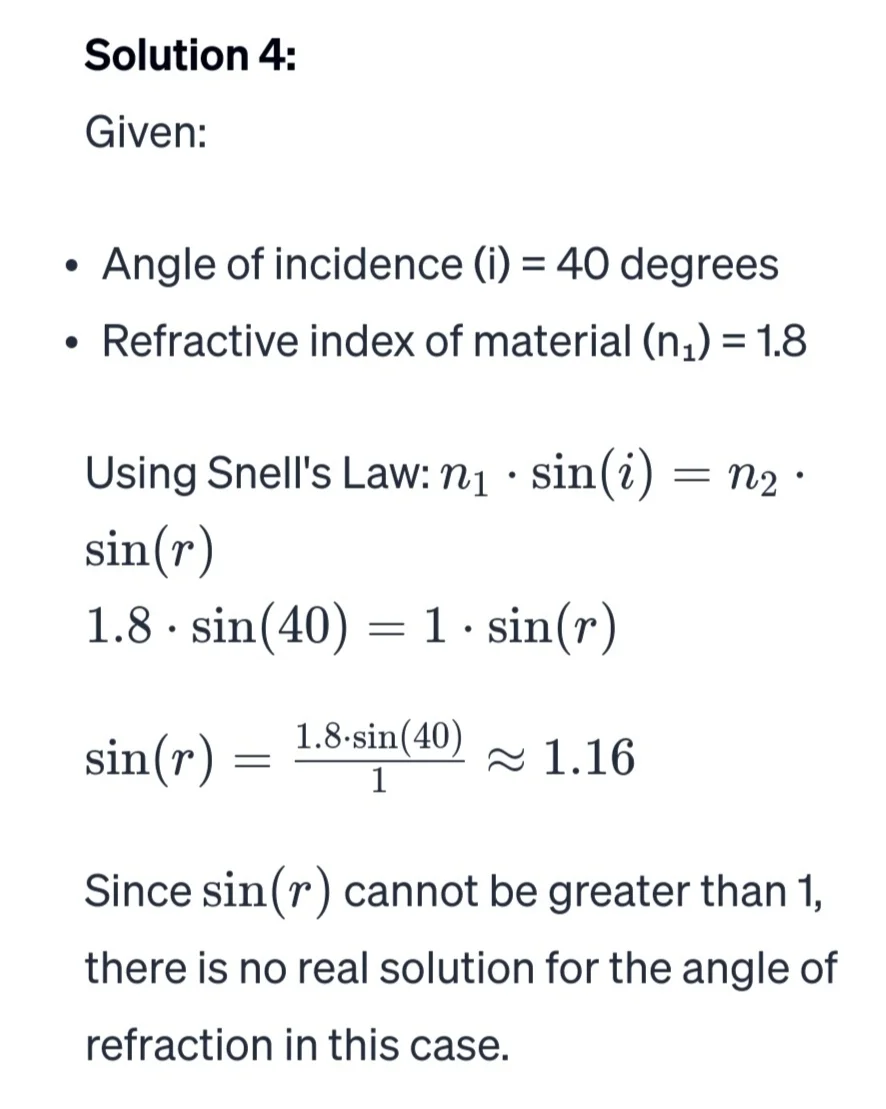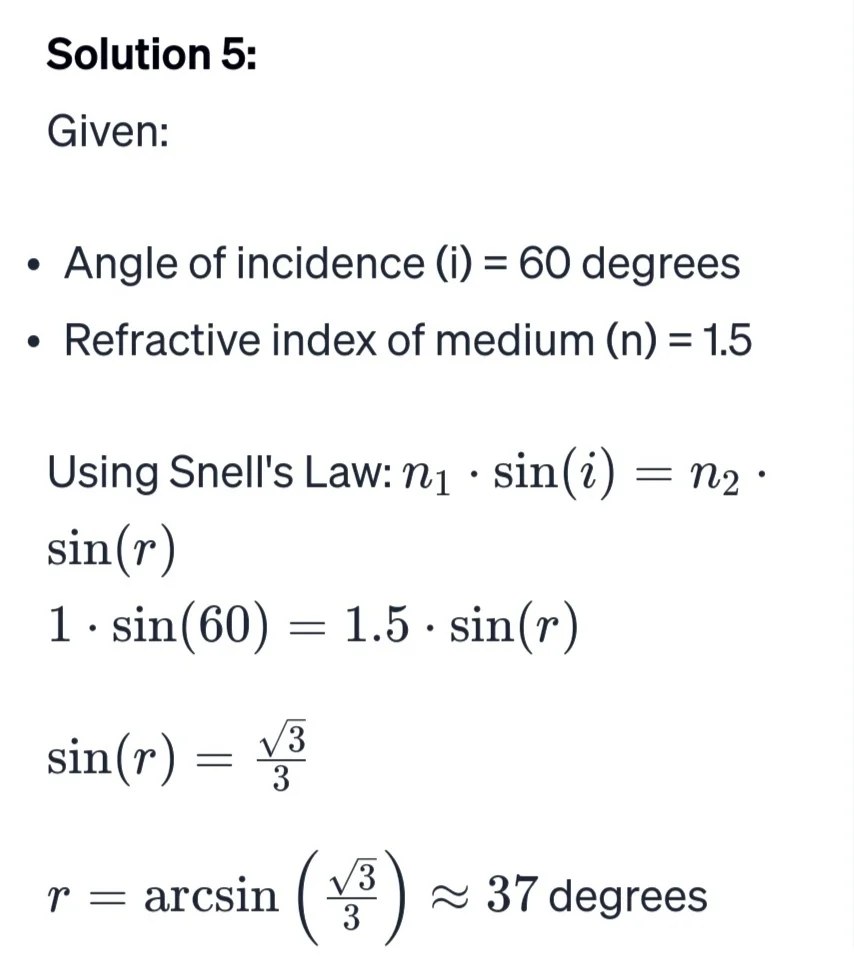The refractive index (R.I) is a fundamental optical property of a material, denoted by the symbol “n.” It quantifies how much light slows down and changes direction when it passes through a substance, compared to its speed in a vacuum. This phenomenon is a consequence of interactions between photons and the atoms or molecules within the material. A higher value signifies a greater bending of light, and it is a crucial factor in various optical phenomena, including the formation of images by lenses, dispersion, and total internal reflection.
Mathematically, it is defined as the ratio of the speed of light in a vacuum to its speed in the material, expressed as n = c/v, where “c” is the speed of light in a vacuum and “v” is the speed of light in the material.
Although it is the most common definition, here are also some alternate definitions which are normally used in higher levels given below …
Refractive Index ( R.I) Definitions and Formulas According to Various Laws Of Physics
The refractive index can be understood through various laws of physics:
1. R.I According to Snell’s Law (Law of Refraction)
Snell’s Law describes how light rays change direction as they pass from one medium to another. It states that the ratio of the sine of the angle of incidence (θ₁) to the sine of the angle of refraction (θ₂) is constant and equal to the refractive index (n) of the second medium relative to the first:
n₁ .sin(θ₁) = n₂.sin(θ₂)
2. Refractive Index According to Wave Theory of Light:
According to the wave theory of light, the refractive index of a medium is the ratio of the speed of light in a vacuum (c) to the speed of light in that medium (v):
n = c/v
3. R.I According to Particle Theory of Light
In the particle theory of light (as described by Isaac Newton), the refractive index can be understood in terms of the interaction between photons (particles of light) and the particles within a medium. The index of refraction indicates how much the speed of photons is reduced and their direction changed upon entering a medium.
4. According to Maxwell’s Electromagnetic Theory
In Maxwell’s theory, light is considered an electromagnetic wave. The r.i is related to the electric and magnetic properties of the material, particularly its permittivity (ε) and permeability (μ). The refractive index (n) is given by:
n = √(μ/ε)
5. Quantum Electrodynamics (QED)
In the framework of quantum electrodynamics, the refractive index is understood as a manifestation of the interaction between photons and virtual electron-positron pairs in a material.
These different perspectives on the r.i provide complementary explanations based on different aspects of light’s behavior, whether wave-like or particle-like. They all converge to describe the same fundamental optical property of materials.
Read Also : Solar Plexus Chakra
Alternative symbols used to Represent Refractive Index
The refractive index is commonly represented by the symbol “n” in most contexts. However, in some scientific literature or specific fields, you might encounter alternative symbols like “μ” (mu) or “η” (eta) to denote refractive index. These variations are not as universally recognized as “n,” but they are occasionally used in specialized contexts. It’s always a good practice to check the specific notation conventions within the particular field or source you are referring to.
Read Also : Hypertime in Physics
Examples of Refractive Index
What factors affect refractive index?
The refractive index of a material depends on several factors, including:
1. Wavelength of Light
The refractive index of a material can vary with the wavelength of light. This phenomenon is known as dispersion. Different wavelengths of light interact differently with the electrons in a material, causing a change in the refractive index.
2. Temperature
Refractive index generally increases with increasing temperature. This is due to the fact that as temperature rises, the atoms or molecules in a material vibrate more vigorously, leading to a higher refractive index.
Read Also : Gene Pharming in India
3. Pressure
Changes in pressure can also influence the refractive index of a material. However, the effect is typically small and may not be as significant as other factors.
4. Density
The density of a material is related to its refractive index. Generally, materials with higher density tend to have higher refractive indices. Although it is not always true.
5. Composition and Structure
The specific arrangement of atoms or molecules in a material can significantly affect its refractive index. For example, crystalline structures may have different refractive indices compared to amorphous or polycrystalline forms of the same material.
6. Purity
The presence of impurities or defects in a material can alter its refractive index. Pure materials tend to have more predictable and consistent refractive indices.
7. Electric and Magnetic Fields
In some cases, applying electric or magnetic fields to a material can alter its refractive index. This phenomenon is known as the electro-optic and magneto-optic effects, respectively.
8. Frequency-Dependent Refractive Index
In some materials, the refractive index may change with the frequency or intensity of the incident light. This is particularly relevant in nonlinear optics.
Read About : Gravity Light
Understanding these dependencies is crucial in various applications of optics, including lens design, fiber optics, and the development of optical devices.
Zero Refractive Index
A “zero refractive index” refers to a theoretical or engineered material with a unique optical property. In such a material, light would not experience any change in speed or direction upon entering it, regardless of the angle of incidence. This is in stark contrast to natural materials, where light typically undergoes refraction, causing it to bend as it transitions from one medium to another.
Achieving a zero refractive index requires unconventional materials and structural designs. One approach involves metamaterials, artificially engineered substances with properties not found in nature. By precisely designing the arrangement and composition of elements within a metamaterial, scientists aim to cancel out the effects of refraction.
The concept of a zero r.i holds immense potential for controlling light in innovative ways. It could lead to breakthroughs in technologies like superlenses, where minute details beyond the diffraction limit could be observed, and in cloaking devices, rendering objects invisible by guiding light around them. While practical applications are still in development, the pursuit of zero refractive index materials represents a frontier in optical science with promising prospects for transformative advancements in optics and photonics.
Read : Voice Cloning Ai Scam
Negative Refractive Index and its Achievement
A “negative refractive index” is a captivating concept in optics, suggesting a material that behaves in a way contrary to what we observe in everyday substances. In a material with a negative refractive index, light would refract, or bend, in a direction opposite to what occurs in typical materials.
Achieving a negative R.I is a significant scientific endeavor, and it’s been realized in engineered materials known as metamaterials. These are specially designed structures, often composed of tiny elements like metals or dielectrics, arranged in intricate patterns. These patterns are engineered to interact with light waves in a unique manner, causing the material to exhibit properties not found in nature.
Metamaterials can be designed to have negative refractive indices by tailoring their electromagnetic response. This means they can refract light in directions opposite to what we observe in conventional materials like glass or water.
The potential applications of such materials are staggering. They can be employed in advanced lenses, enabling unprecedented imaging capabilities. Additionally, they hold promise in cloaking technology, allowing objects to become invisible by redirecting light around them.
While the development of materials with negative r.i value is a cutting-edge area of research, it opens doors to a new realm of possibilities in optics, paving the way for revolutionary advancements in various fields, from telecommunications to medical imaging.
Some Common Problems on R.I
Here are five problems along with their solutions:
Problem 1
A ray of light passes from air into a glass slab at an angle of incidence of 45 degrees. If the refractive index of glass is 1.5, calculate the angle of refraction.
Problem 2
A light ray passes from water into a diamond at an angle of incidence of 60 degrees. If the refractive index of water is 1.33 and that of diamond is 2.42, find the angle of refraction in diamond.
Problem 3:
A ray of light travels from air into a medium with a refractive index of 1.6. If the angle of incidence is 30 degrees, calculate the angle of refraction.
Problem 4
A light ray passes from a material with a r.i of 1.8 into air. If the angle of incidence is 40 degrees, find the angle of refraction.
Problem 5
A ray of light enters a medium with a r.i of 1.5 at an angle of incidence of 60 degrees. Calculate the angle of refraction.
FAQ
1. Why is refractive index always greater than 1?
Refractive index measures how much light slows down in a medium compared to a vacuum. Since light travels fastest in a vacuum (with a r.i of 1), any material will have a value greater than 1. This is because photons interact with atoms or molecules in a medium, causing them to temporarily delay their progress, resulting in a higher r.i.
2. What is the unit of refractive index ?
Refractive index is a dimensionless quantity, meaning it has no units. It is simply expressed as a numerical value, typically greater than 1, representing the factor by which the speed of light is reduced in a particular medium compared to a vacuum.
3. What is the highest refractive index ?
The highest naturally occurring r.i is found in diamond, with a value of approximately 2.42. However, artificially engineered materials known as metamaterials can be designed with even higher refractive indices, allowing for unique optical properties.
4. Can refractive index be less than 1 ?
No, r.i cannot be less than 1. A value less than 1 would imply that light is traveling faster in a medium than in a vacuum, which contradicts the fundamental properties of light.
5. Which has the lowest refractive index ?
Air, with a r.i very close to 1, has one of the lowest r.i of common materials. A vacuum has a r.i of exactly 1.
6. How do you increase r.i ?
R. I can be increased by using materials with higher densities, altering their composition, or creating structured materials like metamaterials. Additionally, changing the wavelength or frequency of light interacting with a material can affect its r.i.

